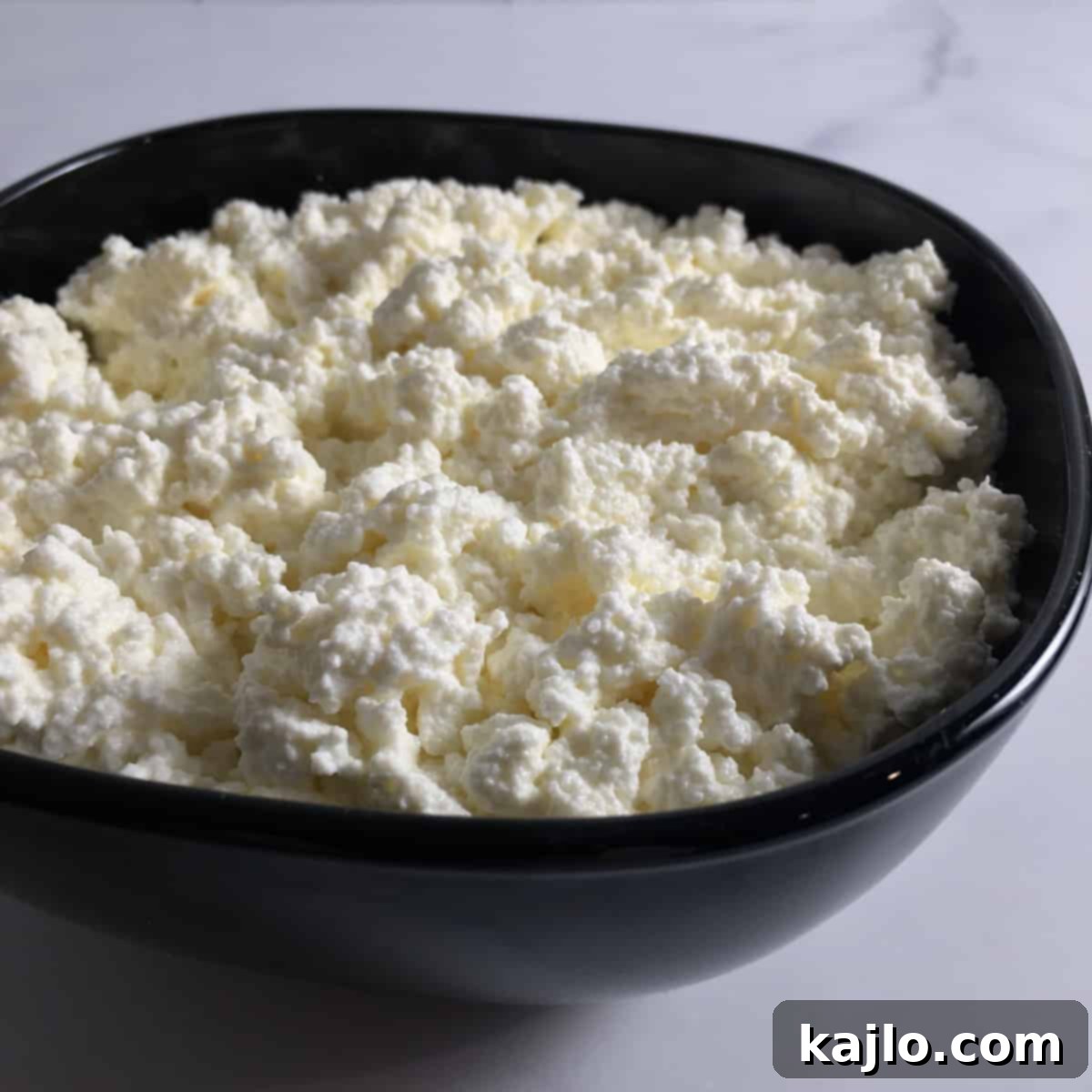Homemade Low Sodium Cottage Cheese: A Simple Guide to Fresh, Healthy Dairy
Did you know that crafting your own low sodium cottage cheese is not only incredibly easy but also uses ingredients you likely already have in your kitchen? This comprehensive guide will walk you through the process of how to make cottage cheese from scratch, including options for producing delicious low fat cottage cheese and absolutely salt-free cottage cheese. By opting for homemade cheese, you can significantly simplify your grocery list and confidently avoid the various additives and preservatives often found in store-bought alternatives. Prepare to elevate your dairy game with this rewarding culinary adventure!

“Thanks for this super simple recipe. 👍🏼 It will get plenty of use.”
– Robyn H.
If you’ve successfully ventured into making homemade yogurt, then preparing your own cottage cheese at home will feel even more straightforward. It’s surprisingly easy and remarkably versatile! With just a minor adjustment to the recipe provided below, your homemade curds can also serve as an excellent substitute for ricotta cheese in various dishes, making it a truly multi-functional dairy product.
One of the most significant advantages of making your own cottage cheese is the unparalleled control you gain over its sodium content. For individuals adhering to a low-sodium diet, finding truly reduced-sodium cottage cheese in stores can be a considerable challenge. Crafting your own salt-free cottage cheese at home presents an effortless and highly effective solution, allowing you to enjoy this creamy, protein-rich food without compromising your dietary needs.
Addressing Common Questions About Cottage Cheese Sodium
Naturally, you might be curious about the sodium levels in store-bought cottage cheese. Let’s tackle some frequently asked questions:
- Is cottage cheese high in sodium?
- How much sodium is typically in cottage cheese?
- Why does cottage cheese often contain so much sodium?
According to the FDA, a food is classified as “high in sodium” if it provides 20% or more of the Daily Value (DV) for sodium per serving. Many commercial brands of cottage cheese typically hover around 15% DV sodium per serving. While this doesn’t technically qualify them as “high sodium,” it’s still a significant amount, especially for those monitoring their intake.
The sodium content in cottage cheese stems from two primary sources: a small amount naturally present in the milk itself, and a larger portion added during processing in the form of salt. While the natural sodium in milk is unavoidable, the beauty of making homemade cottage cheese is that you can completely eliminate or drastically reduce any added salt, thus creating truly salt-free cottage cheese tailored to your preferences.
🥛 Should You Use Raw Milk for Cottage Cheese?
Many enthusiasts eager to learn how to make old-fashioned cottage cheese often ask about using raw milk. While some might suggest it’s easier to culture raw milk, my answer remains a firm no. Raw milk is absolutely not required for making delicious cottage cheese; readily available pasteurized milk from your local grocery store works perfectly.
The FDA strongly advises choosing pasteurized dairy products to minimize the risk of foodborne illnesses. Raw dairy products are categorized as “high risk” due to potential harmful bacteria. For instance, there was a notable outbreak of E. coli O157 in my state several years ago that was directly linked to raw milk consumption.
You may encounter conflicting information on this topic online. For example, one recipe from the Kentucky Cooperative Extension Service states that “high quality raw skim milk is necessary to make a good cottage cheese.” However, even their method still includes pasteurizing the raw milk *before* actually making the cheese.
For a safe and consistently successful homemade cottage cheese experience, I highly recommend sticking with pasteurized milk bought from the store. This ensures food safety without compromising the quality or taste of your final product.
⭐ Homemade Cottage Cheese Nutrition: Healthier, Wholesome & Pure
Beyond the satisfaction of simplifying your grocery runs, incorporating homemade low salt cottage cheese into your diet offers a wealth of other significant health benefits. Chief among these is the complete absence of additives often found in commercial cottage cheese products, giving you a pure, wholesome dairy option.
Store-bought cottage cheese frequently includes stabilizers, thickeners, and preservatives such as carrageenan, locust bean gum, guar gum, and potassium sorbate. When you make it yourself, you eliminate the need for any of these unnecessary ingredients. Here are even more compelling nutritional advantages of preparing your own cottage cheese:
- Truly Low Sodium Cottage Cheese: The FDA defines “low sodium” as a food containing 5% or less DV of sodium per serving. By simply omitting added salt in this recipe, you can easily achieve a delicious cottage cheese that meets this criterion. Furthermore, cottage cheese is naturally a gluten-free food, making it suitable for those with gluten sensitivities or celiac disease.
- High-Quality Protein Powerhouse: Cottage cheese is exceptionally rich in casein, a slow-digesting dairy protein. A typical half-cup serving of cottage cheese usually boasts more protein than the same volume of milk, as the protein becomes concentrated after the liquid whey is carefully drained away. This makes it an excellent choice for satiety and muscle maintenance.
- Essential Vitamins and Minerals: This humble dairy product is packed with a variety of vital nutrients. It’s a fantastic source of calcium and phosphorus, both crucial for bone health, as well as vitamin B12, important for nerve function and red blood cell production, and vitamin A, which supports vision and immune function.
- Low Sodium Cottage Cheese for Babies: When introducing solids to babies, simplicity is key. This homemade cottage cheese, without any added salt, is a superior option compared to commercial versions. Its soft texture and nutrient profile make it a wonderful first food for little ones.
- Customizable Low-Fat Cottage Cheese: You have full control over the fat content. To create a lower-fat, lower-saturated-fat version, simply use low-fat or skim milk and skip the heavy cream at the end. For a richer, higher-fat product, opt for whole milk and incorporate heavy cream. Both methods yield deliciously satisfying results, allowing you to tailor it to your dietary needs and preferences.
🥘 Essential Ingredients for Homemade Low Sodium Cottage Cheese
To embark on your DIY cottage cheese journey, you’ll only need a handful of basic ingredients:
- 2 liters (approximately 8.5 cups) milk
- 6 tablespoons white vinegar or fresh lemon juice (these acidic agents are key to curdling)
- 6 tablespoons heavy cream (optional, for desired creaminess and fat content)
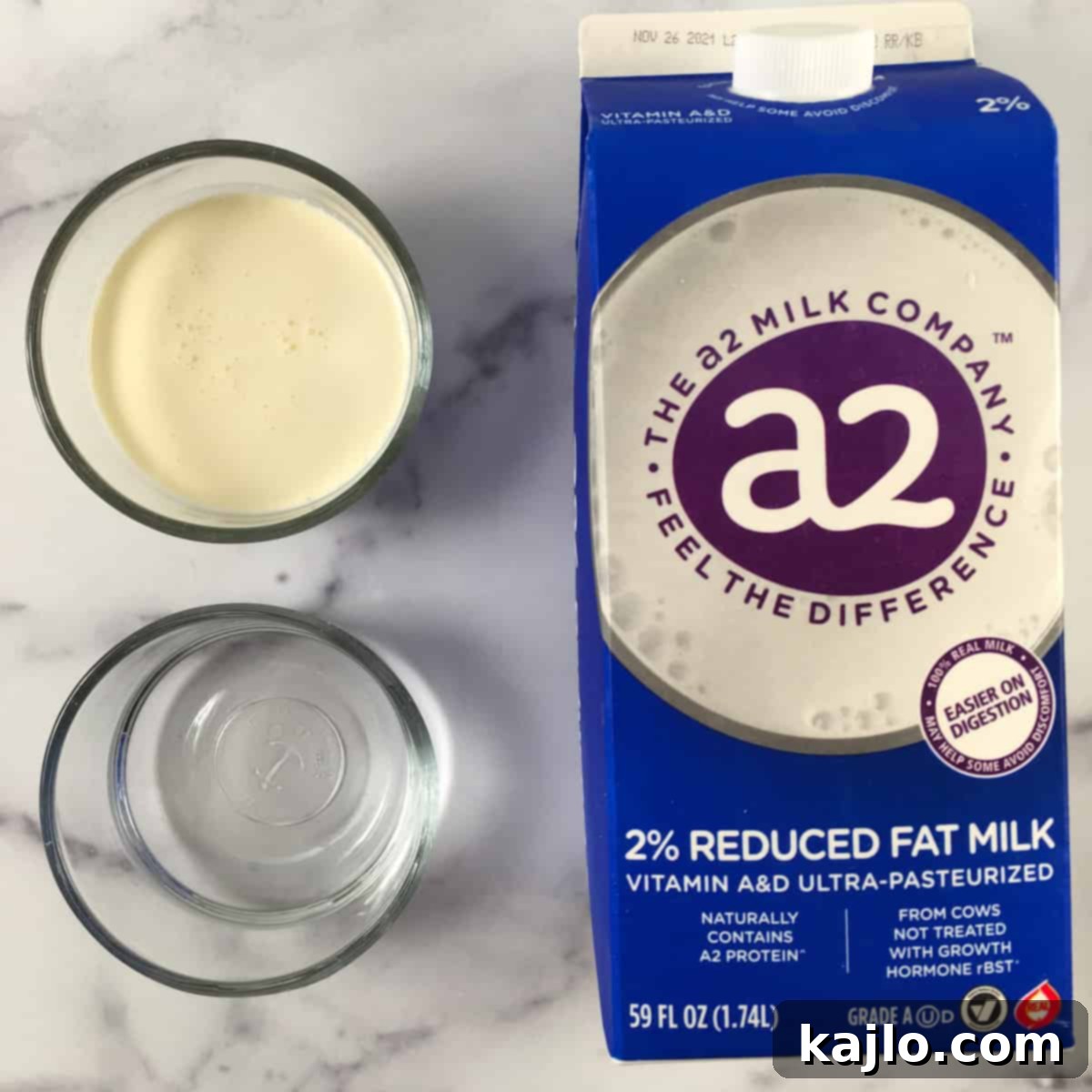
You have the freedom to add a pinch of salt if you prefer, or you can commit to truly no salt added cottage cheese for the lowest sodium profile. This recipe is also incredibly flexible when it comes to milk choice. I’ve successfully experimented with nonfat milk, reduced-fat milk (2% and 1% milk), and whole milk, all yielding excellent results. The choice simply impacts the final fat content and texture.
The final yield of your cottage cheese can vary based on the fat content of the milk you use. For example, one-half gallon (approximately 2 liters) of skim milk typically yields about 2.5 unpacked cups of cottage cheese. The same amount of 2% milk often produces around three unpacked cups. This difference occurs because lower-fat milks result in “drier” milk curds that tend to absorb more cream when it’s added at the final stage. If you’re aiming for a lower-fat version without sacrificing creaminess, consider stirring in yogurt or additional low-fat milk instead of heavy cream.
For those with specific dietary needs, lactose-free milk and A2 milk can be successfully used to make cottage cheese without any issues. However, UHT (ultra-high temperature) milk or ultra-pasteurized milk may not curdle effectively in this recipe due to changes in their protein structure. Most plant-based milks, such as almond or oat milk, generally contain insufficient protein to form proper curds and therefore cannot be used to make traditional cottage cheese.
While I haven’t personally tested these, some readers have reported success using the following milks with this recipe:
- Goat milk
- Sheep milk
- Half and half
- Powdered milk (reconstituted with water)
- Soy milk (ensure it’s a high-protein variety)
Can you make cottage cheese from yogurt? While you can create yogurt cheese or kefir cheese by simply draining the whey, the resulting texture will be distinct from traditional cottage cheese. Yogurt cheese is typically much thicker and smoother, more akin to cream cheese or labneh, rather than the characteristic curds of cottage cheese.
Is cottage cheese made out of rotten milk? While it’s technically possible to make cottage cheese from sour or curdled milk, I strongly advise against it for food safety reasons. Using milk that has started to spoil introduces risks. That said, making cottage cheese is an excellent way to utilize extra milk *before* it begins to turn, ensuring freshness and minimizing waste.
🍽 Essential Equipment for Homemade Cottage Cheese
This method for making cottage cheese is remarkably straightforward, requiring minimal specialized equipment. You won’t even need a cheese press! Here’s the basic kitchen gear you’ll need:
- Large pot: For heating the milk safely and evenly.
- Colander: To hold the cheesecloth and allow the whey to drain.
- Candy thermometer: Crucial for accurately monitoring milk temperature to ensure proper curdling.
- Cheesecloth: Essential for separating the curds from the whey.
This reusable cheesecloth is highly recommended for making cottage cheese. Unlike flimsy, single-use varieties from the grocery store, a good quality, washable cheesecloth will last indefinitely, making it a sustainable and cost-effective investment for your cheesemaking endeavors.
🔪 How to Make Low Sodium Cottage Cheese: Step-by-Step
Now, let’s address the most anticipated question: how does milk transform into cottage cheese? It’s a fascinating process of controlled curdling, and here’s how to do it perfectly:
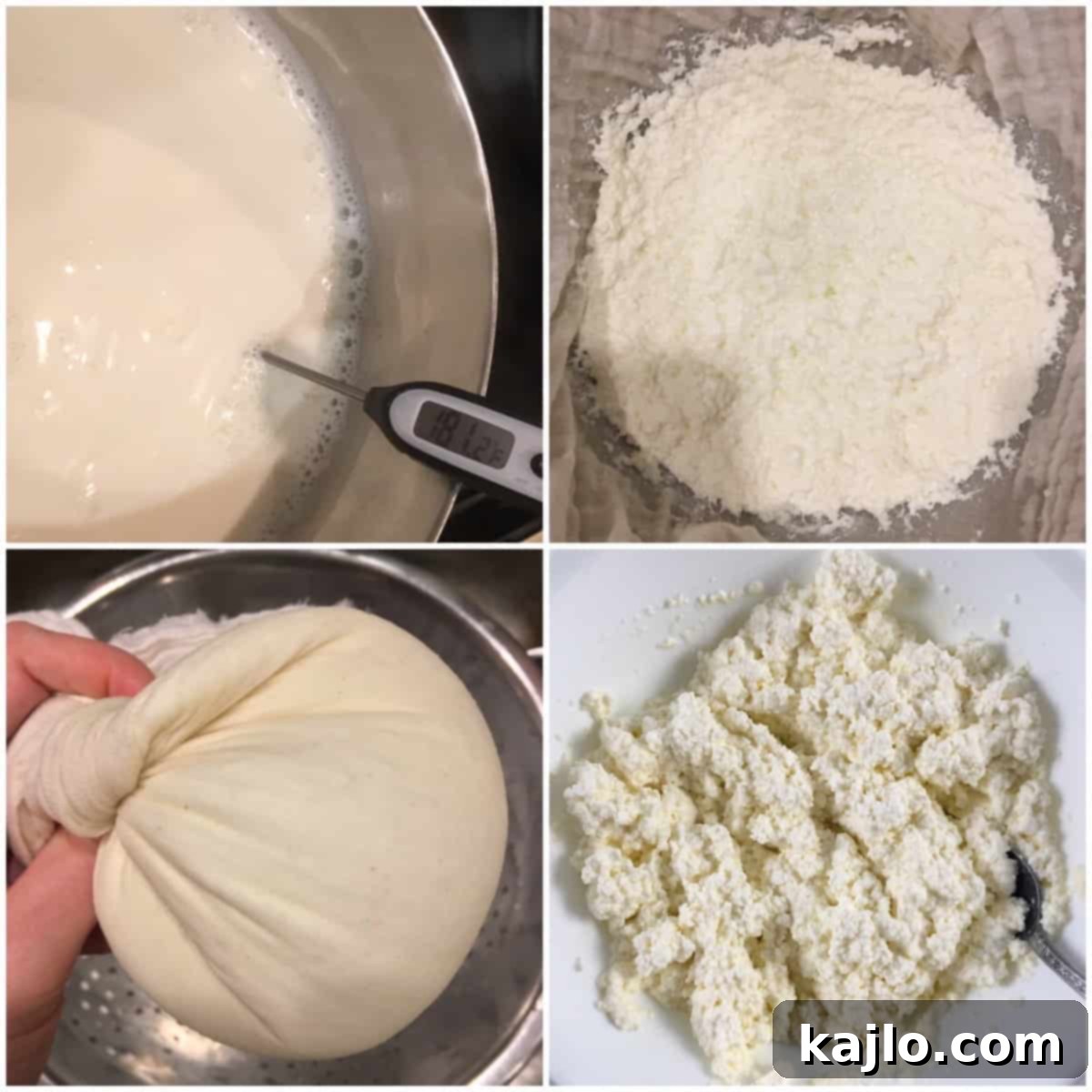
Heat the Milk: Pour the milk into a large pot. Place it over medium heat and gradually bring the milk temperature up to 180°F (82°C). Whisk the milk frequently during this process to prevent scorching and ensure even heating. Using a reliable candy thermometer is crucial here to achieve the precise temperature needed for optimal curdling.
Curdle the Milk: As soon as the milk reaches 180°F (82°C), immediately remove the pot from the heat. Stir in the white vinegar (or fresh lemon juice) right away. You should observe an almost instant separation: the yellowish, translucent whey will begin to separate from the solid white curds. (For your information, this liquid is indeed the whey often mentioned in dairy production.) Allow this mixture of curds and whey to cool undisturbed at room temperature for approximately 30 minutes. This allows the curds to firm up further.
Drain the Curds: Line a colander with a double layer of cheesecloth. Position the lined colander over your sink or a large bowl to catch the draining whey. Carefully pour the curds and whey mixture into the cheesecloth-lined colander. Let it drain for about 5 minutes. The curds will remain trapped in the cheesecloth, while the liquid whey flows through. I typically discard this whey due to its strong vinegar taste and smell, but if you wish, you can save it for other culinary uses (like baking or adding to smoothies).
Squeeze Excess Whey: Gather the edges of the cheesecloth, pulling them together to form a tight ball containing the curds. With clean hands, gently but firmly squeeze the ball over the sink to expel more of the remaining whey. If you’re concerned about a lingering vinegar taste, you can briefly rinse the cheese ball under a very gentle stream of cool running water, then squeeze it again. This step helps to achieve your desired texture and flavor profile.
Transform into Cottage Cheese or Ricotta: Unwrap the cheesecloth. At this stage, the fresh cheese you’ve created can be used directly as a versatile low sodium ricotta cheese substitute in many recipes. Yes, this single base recipe serves as both ricotta and cottage cheese! If you desire traditional cottage cheese, transfer the cheese ball to a clean bowl and use a fork to gently break up the curds to your preferred size (smaller for small curd, larger for large curd). Then, stir in the heavy cream. You’ll notice how readily the curds absorb the cream, resulting in a rich, creamy cottage cheese with minimal excess liquid.
Chill and Enjoy: For the best texture and flavor, refrigerate your freshly made cottage cheese for at least an hour before serving. Then, savor the delightful taste of your homemade creation!

🤔 How Much Milk for a Pound of Cottage Cheese?
The yield of homemade cottage cheese can vary, but generally, if you use 2% cow’s milk for this recipe (2 liters or approximately ½ gallon), you can expect to get around ½ lb. (about 227g) of finished cottage cheese. This means that to produce a full pound of cottage cheese, you would need approximately 4 liters (or 1 gallon) of milk. Keep in mind that yields can be slightly lower if you use milks like sheep’s milk, which have different protein and fat compositions.
Your individual yield will also be influenced by how thoroughly you drain and squeeze the curds. A more vigorous squeeze will remove more whey, resulting in a drier, more concentrated cheese and potentially a slightly lower weight. Conversely, less squeezing will leave more moisture, increasing the final weight but altering the texture. Experiment to find your preferred consistency.
A key characteristic of this recipe’s end product is that the curds readily absorb the cream added at the final step, as you’ll observe in the accompanying photos. The finished cottage cheese will not be excessively liquidy.
Interestingly, I’ve found that skim milk curds absorb even more cream than those made from low-fat milk. For instance, I used about ½ cup of cream with skim milk curds compared to 6 tablespoons with 2% milk curds. This means that starting with skim milk may not necessarily result in a significantly lower-calorie cheese if you add a generous amount of cream at the end. Always consider the total additions when calculating the nutritional impact.
🧀 Exploring Cultured Cottage Cheese
The cottage cheese recipe I’ve shared today prioritizes simplicity and quick results, relying on an acid (vinegar or lemon juice) to curdle the milk. This method is generally easier and more reliable than attempting to make cultured cottage cheese. The main difference is that this direct acid method does not yield cottage cheese with live, active cultures. Some commercial cottage cheeses, similar to yogurt, may contain beneficial live and active cultures, which are often sought after for their probiotic properties.
To produce cultured cottage cheese, you would typically use a starter culture, such as buttermilk or sour cream that explicitly states it contains “live, active cultures.” In this method, instead of vinegar, these cultured dairy products provide the necessary acidity and beneficial bacteria to separate the curd from the whey. The process is a bit more involved.
This approach usually involves adding the buttermilk or sour cream to milk that has been heated and then cooled to a specific temperature. The mixture is then left to sit for several hours, allowing the cultures to work and the curds to form. The cooling step is crucial to prevent the heat from destroying the beneficial bacteria. The desired outcome is probiotic-rich cottage cheese.
However, it’s worth noting that I’ve personally attempted numerous recipes using this cultured method and have struggled to achieve consistent success. Often, after the lengthy curd-setting time, the milk remains largely unchanged, looking exactly as it did when I started. Since the milk sits within the food temperature “danger zone” for many hours during this process, any unsuccessful batch must unfortunately be discarded to prevent potential foodborne illness. This is why for ease, safety, and reliability, the direct acid method is recommended for home cheesemakers.
🌡️ Can I Freeze Homemade Cottage Cheese?
Yes, absolutely! This homemade cottage cheese freezes remarkably well, allowing you to prepare larger batches and enjoy them at your convenience. To freeze, simply place the cottage cheese in an airtight, food-safe container. When you’re ready to use it, transfer the container to your refrigerator and let it defrost slowly overnight. The texture might be slightly softer after thawing, but the flavor will remain excellent.
Does cottage cheese go bad? Like all fresh dairy products, cottage cheese can spoil. It’s essential to keep it properly refrigerated. Any homemade cottage cheese that you don’t plan to consume within 3-4 days should be promptly frozen to maintain its freshness and quality.
🥣 Creative Ways to Enjoy Homemade Cottage Cheese
I am a true enthusiast of cottage cheese, and I find it to be one of the most versatile and satisfying dairy products. One of my absolute favorite ways to enjoy this low salt cottage cheese is paired with fresh fruit. A simple bowl of homemade cottage cheese topped with juicy pineapple chunks and a handful of mixed berries feels like a little slice of heaven. It’s a perfect option for a refreshing breakfast, a light lunch, or even a wholesome, healthy dessert that satisfies sweet cravings without guilt.
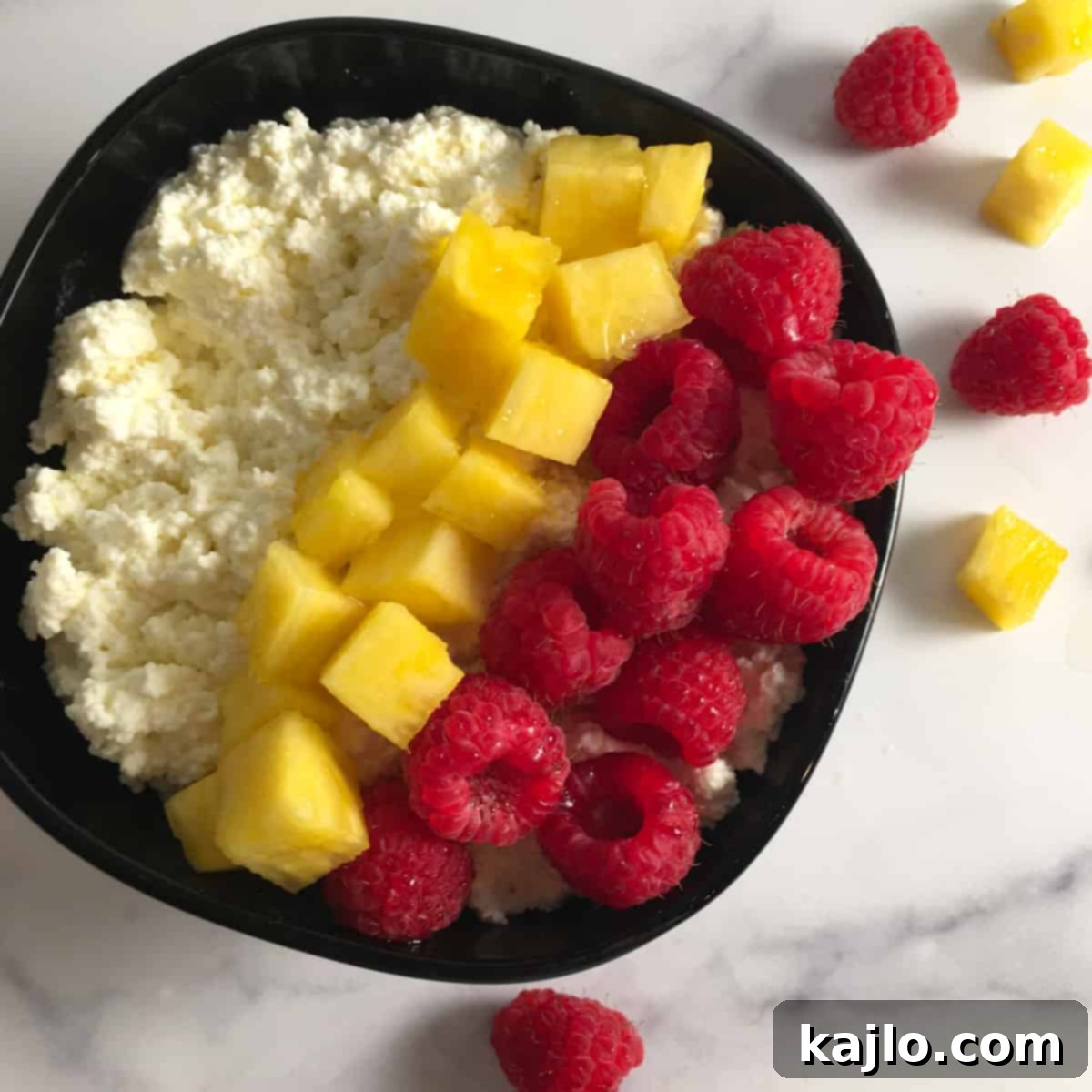
Beyond fruit, the possibilities are endless! You could spoon it generously over crispy air fryer waffles or spread it as a creamy base for your toast, adding savory or sweet toppings as desired. For a sweet treat, feel free to drizzle it with a touch of maple syrup or honey, or blend it with pureed fruit for a naturally sweet enhancement.
This homemade cottage cheese also excels in savory applications. I’ve successfully used it as a fantastic substitute for ricotta cheese in classic lasagna, adding a creamy, rich layer without the extra sodium. It also works wonderfully in pierogies, stepping in for farmer’s cheese. When incorporating it into savory dishes like these, where a less creamy texture is often desired, I typically omit the heavy cream from the recipe to achieve a firmer curd.
Another delicious idea is to use it as a filling for a Mediterranean-inspired omelet, combining it with diced tomatoes, finely chopped onions, and a sprinkle of fresh herbs. Just thinking about these delicious combinations makes me hungry!
📋 Homemade Cottage Cheese Calories & Nutrition Overview
A single serving of this low sodium cottage cheese recipe, prepared with 2% milk and heavy whipping cream, provides approximately 158 calories, 12 grams of net carbohydrates, 118.8 mg of sodium, and a robust 8 grams of protein. Please note that some nutritional values, particularly carbohydrates, may be slightly overestimated as the discarded whey has been included in these calculations. This offers a transparent view of the nutritional profile of your homemade creation.
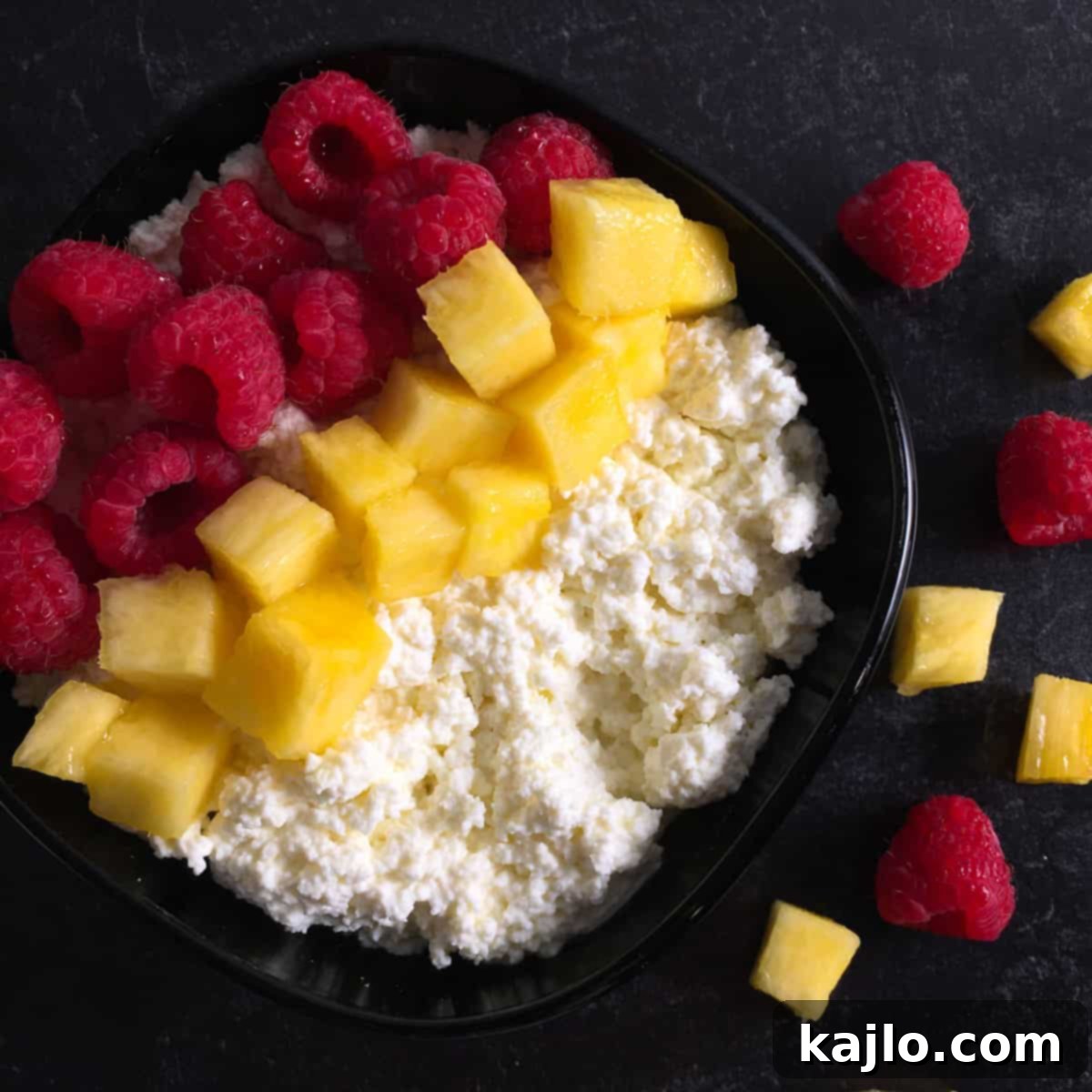
FAQs About Homemade Cottage Cheese
How to make cottage cheese with rennet?
While this recipe uses vinegar for curdling, you can also set the curds for cottage cheese using rennet. Rennet contains enzymes that coagulate milk proteins more slowly and gently than acid, often resulting in slightly different textures. You can find rennet here on Amazon. It’s important to remember that traditional rennet is derived from the stomach of animals, so using it means your finished cottage cheese will not be vegetarian. Vegetarian rennet alternatives are also available if this is a concern.
How to make large curd cottage cheese?
Achieving large curd cottage cheese is quite simple and depends on how you handle the curds after they coagulate and drain. For large curds, instead of mashing them finely, gently break or cut the curds into bigger pieces using a fork or a knife. The less you break them down, the larger your curds will be. Conversely, for small curd cottage cheese, you would mash the curds thoroughly with a fork, as demonstrated in this recipe, to achieve that finer texture.
Cottage cheese vs. ricotta: what’s the difference?
Traditionally, ricotta cheese is made from the whey leftover from cheesemaking, which is why the “ricotta substitute” I’m providing here isn’t true ricotta but rather fresh, unsalted curds. Cottage cheese, on the other hand, is produced in a manner similar to paneer. For cottage cheese, we intentionally coagulate the casein protein in the milk, forming the curds, and then discard the whey. The key distinction lies in what part of the milk product is used and how it’s processed.
What are some low sodium cottage cheese brands?
If you’re in the market for commercially available low-sodium options, look for brands like Lucerne cottage cheese (specifically their “no salt added” variety) or Friendship Dairies “no salt added” cottage cheese. Prairie Farms also offers a “50% less sodium” cottage cheese. While not entirely salt-free, Breakstone’s low-fat small curd cottage cheese is another option that typically contains less sodium than many standard brands. Always check the nutrition label for the most accurate information.
Where can I buy low sodium cottage cheese?
Finding genuinely low-sodium cottage cheese in conventional grocery stores can indeed be a bit of a treasure hunt! Many readers have reported success locating it at larger retailers such as Walmart, Stop and Shop, and Kroger. Smaller or specialty stores like Trader Joe’s might also carry it, but stock can vary. I highly recommend calling your local grocery stores ahead of time to confirm their current availability before making a special trip.
Can you make cottage cheese from almond milk?
Unfortunately, traditional cottage cheese typically cannot be made from standard almond milk. Almond milk is generally too low in protein content to form the solid curds necessary for cottage cheese. However, as dairy alternatives evolve, some brands are now producing “protein almond milk” varieties with significantly higher protein levels. Experimenting with these high-protein almond milks could be a worthwhile endeavor if you’re looking for a plant-based cottage cheese alternative.
👩🏻🍳 Discover More Delicious Cheese Recipes
Are you a fan of cheese? (Who isn’t, right?) If you loved making your own cottage cheese, you might also enjoy exploring these other fantastic cheese-focused recipes:
- Instant Pot Paneer: Learn how to make this fresh, non-melting Indian cheese with ease.
- Keto Cheese Sauce: A rich, creamy, and low-carb sauce perfect for countless dishes.
- Air Fryer Parmesan Crisps: Crispy, savory, two-ingredient snacks made quickly in your air fryer.
- Smoked Stouffer’s Mac and Cheese (Elevated): A unique twist on a comfort food classic using smoked flavors.
Low Sodium Cottage Cheese (Easy Homemade Recipe)
By Summer Yule
Learn how to make your own cottage cheese effortlessly, with options for low-fat and low-sodium versions. It’s simpler than you might think!
Prep Time: 30 mins
Cook Time: 15 mins
Total Time: 45 mins
Course: Breakfast, Side Dish, Snack
Cuisine: American
Servings: 8
Calories: 158 kcal
Ingredients
- 2 liters milk (any fat content will work, choose based on preference)
- 6 tablespoons white vinegar (fresh lemon juice can be used as an alternative)
- 6 tablespoons heavy cream (optional, adjust to desired creaminess and fat level)
Instructions
- On the stovetop, pour the milk into a large pot. Heat the milk over medium heat, whisking occasionally, until it reaches 180°F (82°C). Use a candy thermometer for accuracy.
- Immediately remove the milk from the heat once it reaches temperature. Stir in the vinegar (or lemon juice) right away. You will observe the yellowish whey separating from the curds almost instantly.
- Allow the curds and whey mixture to cool at room temperature for approximately 30 minutes. This helps the curds to set.
- Line a colander with a double layer of cheesecloth. Place the colander in your sink or over a large bowl. Carefully pour the curds and whey into the lined colander and let it drain for 5 minutes. The curds will remain in the cloth while the whey drains away. You can discard the whey or save it for other recipes.
- Gather the edges of the cheesecloth to form a tight ball with the curds. With clean hands, gently squeeze the ball over the sink to release any remaining whey. If you wish to minimize any vinegar taste, you can briefly rinse the curds under a gentle stream of cool water and squeeze again.
- Unwrap the cheesecloth. At this point, the fresh cheese can be used as a low-sodium ricotta substitute in your recipes. If you prefer cottage cheese, proceed to the next step.
- Transfer the cheese ball to a bowl and use a fork to gently break up the curds to your desired size. Stir in the heavy cream. The curds will absorb the cream, resulting in a creamy cottage cheese with minimal liquid.
- If you used 2% milk, this recipe typically yields about three cups of loosely packed cottage cheese. Refrigerate your homemade cottage cheese before serving and enjoy its fresh flavor!
Equipment
- Kitchen Thermometer
- Cheesecloth
- Colander
Notes
💭 Expert Tips from Dietitian Summer Yule
This is a level 1 recipe (may help support fat loss).
Why is cottage cheese considered a good “diet food”?
Cottage cheese is an excellent choice for a snack or as part of a meal if you desire weight loss. According to Cronometer, ½-cup of 2% cottage cheese provides 12 grams of filling protein for only 92 calories. My favorite way to enjoy cottage cheese is with fruits such as pineapple, blueberries, or strawberries.
If you are trying to reduce your calorie intake, keep in mind that one tablespoon of heavy cream provides 50 calories. Adding a few extra glugs of cream into your cottage cheese can easily mean a few hundred additional calories.
Unlike milk, heavy cream should be thought of as an added fat, similar to butter. Though cream is fine (and delicious!) to use in moderation, it’s not the best choice if you are looking to lower your saturated fat intake.
For low-calorie cottage cheese, stir milk or yogurt into the cottage cheese at the end instead of cream. This swap will also give you a low-fat cottage cheese if you use low-fat or nonfat dairy.
Which is healthier, ricotta or cottage cheese? “Healthy” always depends on what your needs are. In this recipe, the ricotta (cheese without added cream) is the better option for lower calories and saturated fat.
If you need a high-calorie cheese or want weight gain, cottage cheese with cream is a better choice.
Nutrition information is for one serving. This is for cottage cheese made with 2% milk and heavy whipping cream. Some nutrition values (such as carbs) may be an overestimate as the discarded liquid has been included in this information.
nutrition info disclaimer
All recipes on this website may or may not be appropriate for you, depending on your medical needs and personal preferences. Consult with a registered dietitian or your physician if you need help determining the dietary pattern that may be best for you.
The nutrition information is an estimate provided as a courtesy. It will differ depending on the specific brands and ingredients that you use. Calorie information on food labels may be inaccurate, so please don’t sweat the numbers too much.
“To taste” means to your preferences, which may have to be visual to follow food safety rules. Please don’t eat undercooked food x
Nutrition
Calories: 158 kcal
Carbohydrates: 12g
Protein: 8g
Fat: 9.5g
Saturated Fat: 5.6g
Sodium: 118.8mg
Potassium: 376.3mg
Vitamin A: 10% DV
Calcium: 30% DV
Keywords: cottage cheese, cottage cheese no salt, cottage cheese salt free, how to make cottage cheese, how to make low fat cottage cheese, how to make low sodium cottage cheese, low salt cottage cheese, low sodium cottage cheese, low sodium cottage cheese recipe, make your own cottage cheese
Shop our cookbook! Easy Air Fryer Recipes for One
Burning your air fryer recipes? Here’s how to fix it!
Join our community! Subscribe for all of the latest and greatest recipes, and follow me on Facebook, Pinterest, Instagram, and YouTube!
